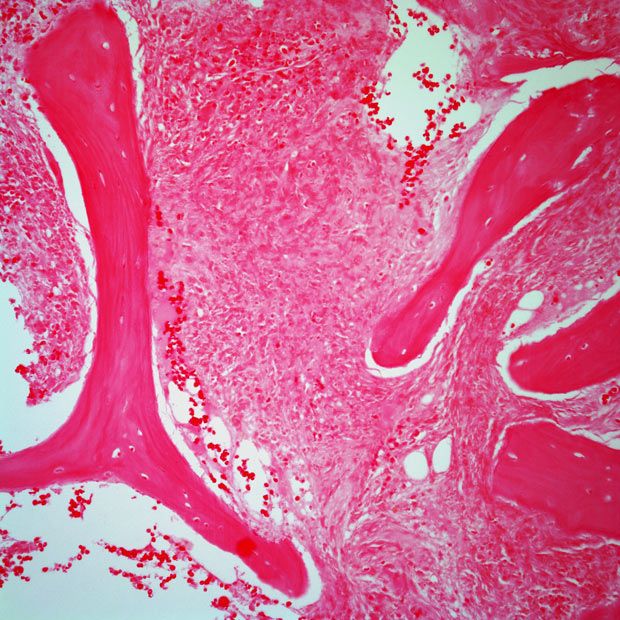Pembrolizumab/Chemo May Prolong Survival in Classic Hodgkin Lymphoma
The addition of pembrolizumab to conventional chemotherapy appears tolerable and effective in a cohort of patients with relapsed/refractory classic Hodgkin lymphoma, according to data from a phase 2 trial.
Pembrolizumab (Keytruda) appeared to prolong survival in combination with conventional ifosfamide, carboplatin, and etoposide (ICE) chemotherapy among patients with relapsed/refractory Hodgkin lymphoma planning to undergo autologous hematopoietic stem cell transplant (AHSCT), according to data from a phase 2 nonrandomized clinical trial (NCT03077828) published in JAMA Oncology.
"The addition of checkpoint inhibitors has the potential to substantially increase the number of patients with relapsed or refractory disease who are eligible for AHSCT and the overall success rate of salvage therapy," according to the study authors.

The overall response rate (ORR) for the 37 evaluable patients was 97.3% (95% CI, 85.8%-99.9%), including partial responses (PRs) in 10.8% (95% CI, 3.0%-25.4%) of patients and complete responses (CRs) in 86.5% (95% CI, 71.2%-95.5%). The 2-year estimated progression-free survival (PFS) rate was 87.2% (95% CI, 77.3%-98.3%); the corresponding figure for overall survival (OS) rate was 95.1% (95% CI, 88.8%-100%). These survival outcomes met the primary end point of outperforming estimated historical outcomes with second-line chemotherapy regimens.
Responses were assessed using 18F-fluorodeoxyglucose–positron emission tomography with computed tomography (FDG-PET/CT) imaging. Investigators also biopsied new areas of FDG-PET positivity in 2 patients, which revealed noncaseating granuloma in 1 and a reactive lymph node in the other.
“Multiple studies have demonstrated that achievement of a CR by FDG-PET/CT to second-line treatment is a powerful predictor of outcome with AHSCT,” the investigators wrote. “Hence, improving the CR rate to salvage regimens is a high priority that is expected to translate into better clinical outcomes, including OS…. The addition of checkpoint inhibitors has the potential to substantially increase the number of patients with relapsed or refractory disease who are eligible for AHSCT and the overall success rate of salvage therapy.”
Investigators of this single-arm, nonrandomized phase 2 studyenrolled 37 patients from 5 institutions over an accrual period lasting from April 20, 2017, to October 29, 2020. Of this population, 43% had primary refractory disease, and 32% had relapsed disease within a year of completing frontline therapy. Additionally, 16% had bulky disease at the time of enrollment. The frontline therapy used for 92% of patients was a combination of doxorubicin, bleomycin, vinblastine, and dacarbazine. More patients had stage I/II disease (46%) than stage III/IV disease (38%) at baseline.
The median age was 34 years old (range, 19-70). Most patients were female (68%) and White (70%), with other patients in the study identifying as African American (16%) or Asian (3%).
Patients received intravenous pembrolizumab at a dose of 200 mg on day 1 of each of 2 cycles. They also received standard ICE salvage chemotherapy, which consisted of ifosfamide at a dose of 5 g/m2 on day 2 accompanied by an equivalent dose of mesna (Mesnex) given over 24 hours by continuous intravenous infusion, intravenous carboplatin with area under the curve of 5 to a maximum of 800 mg on day 2, and intravenous etoposide at a dose of 100 mg/m2 per day on days 1 to 3. Treatment cycles began every 21 days. Following the second cycle, stem cell mobilization and collection were completed, after which patients received a single cycle of pembrolizumab monotherapy.
The study’s primary end point was CR rate. Secondary end points included PFS, OS, stem cell mobilization, and adverse effects (AEs).
A total of 42 patients received at least a single dose of pembrolizumab and were therefore included in the safety analysis. Overall, 81% experienced AEs that investigators attributed to the treatment. Grade 3/4 AEs occurred in 22 patients, including 15 instances of thrombocytopenia, 11 instances of anemia, 9 instances of neutropenia, 10 instances of lymphopenia, and 12 instances of leukopenia.
Six serious AEs considered to be potentially associated with pembrolizumab occurred in 5 patients. One patient with significant coronary artery disease experienced ventricular fibrillation during stem cell collection. Another patient experienced acute respiratory failure during white blood cell count recovery after AHSCT; aside from this instance, no significant pembrolizumab-related autoimmune events delayed treatment on protocol. Serious AEs were all grade 1/2.
“We found that pembrolizumab administered concurrently with conventional ICE chemotherapy was a well-tolerated and effective treatment strategy for patients with relapsed or refractory classic Hodgkin lymphoma, resulting in high CR rates and nearly all patients proceeding to AHSCT,” investigators concluded. “Pseudoprogression, flare reactions, and granulomatous and reactive processes may obscure the true complete metabolic response rate in the presence of checkpoint inhibitors, making it difficult to directly compare outcomes with those of conventional regimens.”
Investigators suggested that larger, randomized, phase 3 trials comparing standard chemotherapy alone to regimens containing checkpoint inhibitors like pembrolizumab in this disease space will be needed to verify these findings.
Reference
Bryan LJ, Casulo C, Allen PB, et al. Pembrolizumab added to ifosfamide, carboplatin, and etoposide chemotherapy for relapsed or refractory classic Hodgkin lymphoma: a multi-institutional phase 2 investigator-initiated nonrandomized clinical trial. JAMA Oncol. Published online March 16, 2023. doi:10.1001/jamaoncol.2022.7975
Highlighting Insights From the Marginal Zone Lymphoma Workshop
Clinicians outline the significance of the MZL Workshop, where a gathering of international experts in the field discussed updates in the disease state.